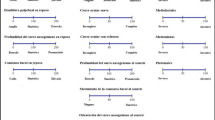Abstract
The objective of this paper is to assess synkinesis associated with post paretic voluntary facial movements using the objective OSCAR method and to investigate the correlation between synkinesis and paresis to compare the objective results with the subjective scaling systems of Fisch and House–Brackmann. The development of an objective assessment of synkinesis with the OSCAR method is focused on the clinically most relevant eye-mouth and forehead-mouth synkinetic movements. Thirteen patients with unilateral facial paralysis and synkinesis of the University Hospital Zurich were examined. Two types of clinically relevant facial synkinesis were found: a maximal synkinesis and a relative synkinesis. Neither Synkinesis-Index correlates well with the underlying degree of global facial palsy. The relative Synkinesis-Index (rSI) correlates well with the subjective evaluation of synkinesis according to the Fisch Grading, but shows a poor correlation with the traditional House–Brackmann grading. Therefore a single scaling index combining the degree of facial nerve palsy and synkinesis is inappropriate and we propose the use of two independent scaling systems for the evaluation of facial palsy: one for the voluntary facial movements, the other for the involuntary synkinetic movements. The adequate evaluation of the post paretic face should include the results of both scaling systems.

Similar content being viewed by others
References
House JW (1983) Facial nerve grading systems. Laryngoscope 93:1056–1069
House JW, Brackmann DE (1985) Facial nerve grading system. Otolaryngol Head Neck Surg 93:146–147
Rickenmann J, Jaquenod C, Cerenko D, Fisch U (1997) Comparative value of facial nerve grading systems. Otolaryngol Head Neck Surg 117:322–325
Fisch U (1981) Surgery for bells palsy. Arch Otolaryngol 107:1–11
Yanagihara N (1977) Classification and standardized documentation of surgical results. In: Fisch U (ed) Facial nerve surgery. Proceedings of the third international symposium on facial nerve surgery; Zurich, Switzerland, 1976. Kugler Medical, Amstelveen, pp 533–536
Coulson SE, Croxson GR (1995) Assessing physiotherapy rehabilitation outcomes following facial nerve paralysis. Aust J Otolaryngol 2(1):20–24
Ross BG, Fradet G, Nedzelski JM (1996) Development of a sensitive clinical facial grading system. Otolaryngol Head Neck Surg 114(3):380–386
Neely JG, Cherian NG, Dickerson CB, Nedzelski JM (2010) Sunnybrook facial grading system: reliability and criteria for grading. Laryngoscope 120(5):1038–1045
Gallati V, Scriba H (1994) Computer assisted facial nerve grading. 1st International Skull Base Congress, Hannover, 1992. In: Samij MS (ed) Skull base surgery, Karger, pp 1211–1213
Gallati V, Scriba H (1994) Computer analysis of facial movements. In: VII International Symposium on the Facial Nerve, Köln, 1992. Europ Arch Oto-Rhino-Laryngol, Suppl, pp 187–188
Scriba H, Meier-Gallati V, Pollak A, Scherler M, Fisch U (1995) Objective evaluation of facial function. In: Proceedings of 4th international muscle symposium, Zurich, pp 172–174
Meier-Gallati V, Scriba H, Fisch U (1998) Objective scaling of facial nerve function based on area analysis (OSCAR). Otol Head Neck Surg 118:545–550
Meier-Gallati V, Scriba H (2000) Validation of objective measure of facial paralysis. Laryngoscope 10(1):177–178
Burres SA (1985) Facial biomechanics: the standards of normal. Laryngoscope 95:708–714
Burres S, Fisch U (1986) The comparison of facial grading systems. Arch Otolaryngol Head Neck Surg 112:755–758
Frey M, Jenny A, Giovanoli P, Stüssi E (1994) Development of a new documentation system for facial movements as a basis for the international registry for neuromuscular reconstruction in the face. Plast Reconstr Surg 93:1334–1349
Isono M, Murata K, Tanaka H, Kawamoto M, Azuma H (1996) An objective evaluation method for facial mimic motion. Otolaryngol Head Neck Surg 114:27–31
Kuzon WM, Marcus JR, Johnson PJ (1995) A comparison of methods for the quantification of facial movements. In: Proceedings of 4th international muscle symposium, Zurich, pp 179–181
Neely JG, Cheung JY, Wood M, Byers J, Rogerson A (1992) Computerized quantitative dynamic analysis of facial motion in the paralyzed and synkinetic face. Am J Otol 13:97–107
Moran CJ, Neely JG (1996) Patterns of facial nerve synkinesis. Laryngoscope 106:1491–1496
Acknowledgements
We are very grateful to Prof. Ugo Fisch for the fruitful discussions, the enormous support and the review of this paper. We thank the patient for his informed consent to publish the photographs.
Author information
Authors and Affiliations
Corresponding author
Ethics declarations
Conflict of interest
Author Verena Meier-Gallati declares that she has no conflict of interest. Author Henning Scriba declares that he has no conflict of interest.
Ethical approval
All procedures performed in studies involving human participants were in accordance with the ethical standards of the institutional and national research committee and with the 1964 Helsinki declaration and its later amendments or comparable ethical standards.
Informed consent
Informed consent was obtained from all individual participants included in the study. Additional informed consent was obtained from all individual participants for whom identifying information is included in this article.
Rights and permissions
About this article
Cite this article
Meier-Gallati, V., Scriba, H. Objective assessment of the reliability of the House–Brackmann and Fisch grading of synkinesis. Eur Arch Otorhinolaryngol 274, 4217–4223 (2017). https://doi.org/10.1007/s00405-017-4770-x
Received:
Accepted:
Published:
Issue Date:
DOI: https://doi.org/10.1007/s00405-017-4770-x




